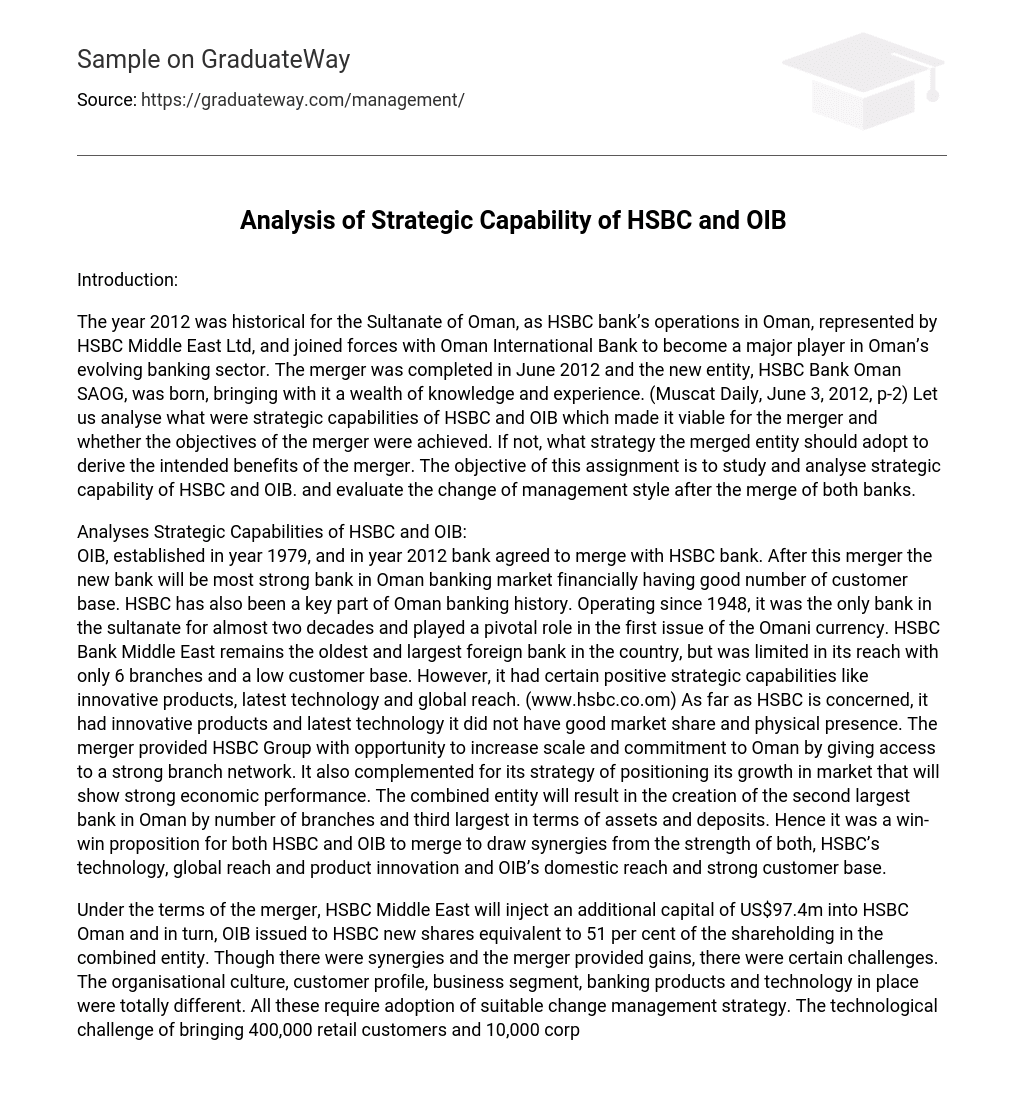Introduction:
The year 2012 was historical for the Sultanate of Oman, as HSBC bank’s operations in Oman, represented by HSBC Middle East Ltd, and joined forces with Oman International Bank to become a major player in Oman’s evolving banking sector. The merger was completed in June 2012 and the new entity, HSBC Bank Oman SAOG, was born, bringing with it a wealth of knowledge and experience. (Muscat Daily, June 3, 2012, p-2) Let us analyse what were strategic capabilities of HSBC and OIB which made it viable for the merger and whether the objectives of the merger were achieved. If not, what strategy the merged entity should adopt to derive the intended benefits of the merger. The objective of this assignment is to study and analyse strategic capability of HSBC and OIB. and evaluate the change of management style after the merge of both banks.
Analyses Strategic Capabilities of HSBC and OIB:
OIB, established in year 1979, and in year 2012 bank agreed to merge with HSBC bank. After this merger the new bank will be most strong bank in Oman banking market financially having good number of customer base. HSBC has also been a key part of Oman banking history. Operating since 1948, it was the only bank in the sultanate for almost two decades and played a pivotal role in the first issue of the Omani currency. HSBC Bank Middle East remains the oldest and largest foreign bank in the country, but was limited in its reach with only 6 branches and a low customer base. However, it had certain positive strategic capabilities like innovative products, latest technology and global reach. (www.hsbc.co.om) As far as HSBC is concerned, it had innovative products and latest technology it did not have good market share and physical presence. The merger provided HSBC Group with opportunity to increase scale and commitment to Oman by giving access to a strong branch network. It also complemented for its strategy of positioning its growth in market that will show strong economic performance. The combined entity will result in the creation of the second largest bank in Oman by number of branches and third largest in terms of assets and deposits. Hence it was a win-win proposition for both HSBC and OIB to merge to draw synergies from the strength of both, HSBC’s technology, global reach and product innovation and OIB’s domestic reach and strong customer base.
Under the terms of the merger, HSBC Middle East will inject an additional capital of US$97.4m into HSBC Oman and in turn, OIB issued to HSBC new shares equivalent to 51 per cent of the shareholding in the combined entity. Though there were synergies and the merger provided gains, there were certain challenges. The organisational culture, customer profile, business segment, banking products and technology in place were totally different. All these require adoption of suitable change management strategy. The technological challenge of bringing 400,000 retail customers and 10,000 corporate clients of more than 80 branches under one unified banking platform and connecting more than 140 ATMs to the OmanNet National Switch Network were completed by the bank well ahead of its scheduled target. In addition, issue of fresh ATM/Debit cards to ex-OIB customers were achieved in record time. HSBC Bank Oman also made changes in the business process by making a number of lending policy changes to benefit its customers, rolled out complimentary life insurance on personal loans, launched receivables finance besides providing value added services like on-the-ground payments and cash management proposition to strengthen client’s coverage capabilities. (www.hsbc.co.om)
Change of management style:
The bank successfully manages the changes required in technology, business practices and physical infrastructure. However, the biggest challenge for the bank will be integrating the workforce and bringing across a uniform Organisational Culture. Towards this aim and in line with the National Objectives to retain all the 1300 people of both banks, HSBC trained ex-OIB staff to new working culture and banking products of HSBC group. Unlike other challenges, this one will be difficult to quantify and could be gauged only by the success of the merged entity in terms of its market share and financial performance.
Conclusions:
Though the bank has achieved significant progress in initial challenges like technological and organisational integration, the impact on its business can be gauged only after looking at the financial results of the bank and its market share in 2013 and 2014. However, with a newly expanded team, diverse geographical network and growing customer base, the business opportunities for HSBC Bank Oman are significant. No doubt the merger creates an opportunity for the bank to drive growth in Oman and thereby having a strong presence in the Gulf and demonstrate its commitment.





